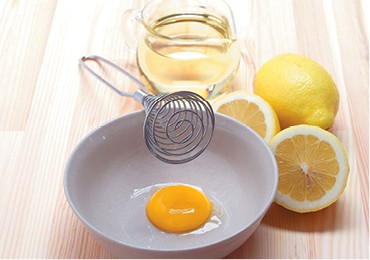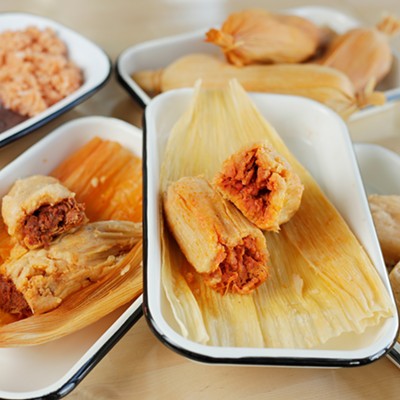Americans eat more mayonnaise than any other condiment, according to Businessweek, which named three mayo brands in the top six selling condiments. The proliferation of niche mayo brands, and at least one gourmet mayo shop, suggest it could undergo a bacon-like renaissance. Clearly, we love our mayo, but we do we know why?
The other three condiments in Businessweek's top six were ketchup, salsa, and Miracle Whip, which is often conflated with mayonnaise. But Miracle Whip is thickened with starch, while mayonnaise achieves its coveted body via the process of emulsification. An emulsion occurs when two liquids that typically don't mix are coerced into doing so, thanks to the presence of an emulsifier. In the case of mayonnaise, the emulsifier is lecithin, which is found in egg yolk, among other places.
This emulsification is a key aspect of why mayo behaves the way it does, and can also be a source of confusion. Scott Jones, Chef de Cuisine at Boston's No. 9 Park, loves mayo with a passion that renders him basically unable to comprehend that people exist who don't like it. He blames lack of understanding about emulsification.
"I have never understood why people don't like mayonnaise, because in its essence it's just a vinaigrette that has been stabilized with egg yolk," Jones told me by phone.
Mayonnaise should have a humble, complementary flavor that doesn't steal the show, but is assertive enough to improve the food. And it needs that custard-like texture that will add body to food, instead of collapsing into Miracle Puddle. Beyond the process of emulsion at its core, according to Jones, mayo is essentially a distillation of French cuisine that you can dollop onto whatever's on the table.
"Mayonnaise, smeared on something, just makes it more delicious. All you've done is just add some fat and some vinegar, which is really everything that the French want on everything. Mayonnaise is like the perfect balance of things. It's just like a decent vinaigrette, you've got the texture from the fat, and the heaviness, and the lightness from the acidity. That's what I want on everything."
By Jones' standard, egg yolk shouldn't be essential, as a vinaigrette could be stabilized with a different emulsifier. But when I told Jones that I prefer Vegenaise — a mayo-like product emulsified with soy lecithin and not egg yolk — it rocked him.
"Oh no," he moaned.
He then launched into a story about the inferiority of Whole Foods mayo, as if assuming that I'm into Vegenaise because it's healthier. True mayo lovers will rarely make concessions, in terms of mayo performance and flavor, for the sake of healthy or natural. My preference for Vegenaise may look like an exception to this pattern, but I'm not a vegan.
Gail Vance Civille is president of the consulting firm Sensory Spectrum, which specializes in "linking product understanding and consumer understanding." She says a key quality of mayo is "lubricity," which she describes as, "moistness — a fatty moistness as opposed to a wet moistness, which makes it easier to eat. If you were to eat tuna fish out of a can, it would not be easy to eat because it's so dry. When you add mayonnaise, it adds a nice lubricity that makes it easier to chew and swallow."
The egg flavor in mayo, she told me, is important to her, but she was open to the possibility that another oil/acid emulsion could hold its own in the lubricity department. Chef Jones also acknowledged as much.
"We had a vegan come in and order a salad that we have on the menu that has mayonnaise as a main component. I felt bad giving her the salad without mayonnaise. So we made some vegan mayonnaise on the fly, and we were impressed with how it came out."
His emulsifier: soy lecithin, the very emulsifier used in Vegenaise.
"It does a good job," he admitted. The vegan mayo "came out tasting pretty good, actually. I was impressed."
An emulsion is like a marriage, and the emulsifier is like the officiant. While this person, and what he or she stands for, is important and must be chosen carefully, it is the bride and groom who will make or break the partnership. The success or failure of mayo depends less on how it came to be than what it does.
"It's the lubricity, the moistness, and the compatibility of the flavor with the things you put it in," Civille summarized. ♦
Put two eggs in a blender, with a teaspoon of Dijon mustard and 3/4 teaspoon salt, and blend for one minute. With the blender still going, add oil — olive, grape seed and sunflower oils work best — very slowly, just a thin drizzle at first, and then faster as it starts to thicken. With the motor still running, add 2 tablespoons each of lemon juice and vinegar. Drizzle in more olive oil until it's the right thickness, and adjust salt and vinegar to taste. Finally, stir in by hand whatever other seasonings you may desire, such as minced garlic. Store it in the fridge.

















